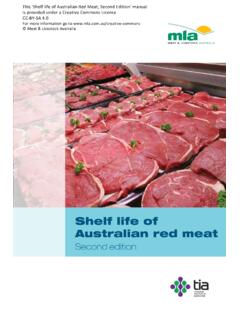Transcription of Supply Support Activity Operations June 2014
1 ATP Supply Support Activity Operations june 2014 DISTRIBUTION RESTRICTION. Approved for public release; distribution is unlimited. Headquarters, Department of the Army This publication is available at Army Knowledge Online ( ). To receive publishing updates, please subscribe at *ATP (FM 10-15) Distribution Restriction: Approved for public release; distribution is unlimited. *This publication supersedes FM 10-15 dated 12 December 1990. i Army Techniques Publication No. Headquarters Department of the Army Washington, DC, 9 june 2014 Supply Support Activity Operations Contents Page iii INTRODUCTION .. iv Chapter 1 Supply MISSION OVERVIEW.
2 1-1 Supply and Storage .. 1-1 Support Requirements .. 1-4 Organizational Relationships .. 1-5 Roles and Responsibilities .. 1-8 Chapter 2 ESTABLISH A Supply POINT .. 2-1 Deploying to an Undeveloped Area .. 2-1 Deploying to a Developed Area .. 2-8 Chapter 3 SUSTAINMENT Operations IN THEATER .. 3-1 Warehouse Operations .. 3-1 Performing Inventories .. 3-8 Tools and Equipment .. 3-9 Chapter 4 REDEPLOYMENT .. 4-1 GLOSSARY .. Glossary-1 REFERENCES .. References-1 INDEX .. Index-1 Figures Figure 1-1. Notional storage location with all storage types .. 1-4 Figure 1-2. Organizational relationships.
3 1-6 Figure 2-1. Notional Supply Support Activity (SSA) field layout plan .. 2-2 Figure 2-2. Field storage layout .. 2-3 Figure 2-3. Bin storage .. 2-5 Contents ii ATP 9 june 2014 Figure 2-4. Tent storage layout .. 2-6 Figure 2-5. Van storage layout .. 2-7 Figure 3-1. Properly loaded heavy load .. 3-6 Figure 3-2. Tail gate load .. 3-7 Figure 3-3. Forklifts .. 3-10 Tables Table 1-1. Classes of Supply .. 1-1 9 june 2014 ATP iii Preface Army Techniques Publication (ATP) , Supply Support Activity Operations , provides specific guidance on planning, organizing, directing, coordinating, and controlling Supply Support . It is relevant to all logistics units at all levels. It is consistent with joint and multinational doctrine. The principal audience for ATP is all members of the profession of arms.
4 Commanders and staffs of Army headquarters serving as joint task force or multinational headquarters should also refer to applicable joint or multinational doctrine concerning the range of military Operations and joint or multinational forces. Trainers and educators throughout the Army will also use this manual. Commanders, staffs, and subordinates ensure that their decisions and actions comply with applicable United States, international, and, in some cases host-nation laws and regulations. Commanders at all levels ensure that their Soldiers operate in accordance with the law of war and the rules of engagement. (See Field Manual [FM] 27-10.) ATP uses joint terms where applicable. Selected joint and Army terms and definitions appear in both the glossary and the text.
5 For definitions shown in the text, the term is italicized and the number of the proponent publication follows the definition. This publication is not the proponent for any Army terms . ATP applies to the Active Army, Army National Guard/Army National Guard of the United States, and United States Army Reserve unless otherwise stated. The proponent of ATP is the United States Army Quartermaster School. The preparing agency is United States Army Combined Arms Support Command G3 Training Support and Doctrine Directorate. Send comments and recommendations on a DA Form 2028 (Recommended Changes to Publications and Blank Forms) to Commander, United States Army Combined Arms Support Command, ATTN: ATCL-TS (ATP ), 2221 A Ave, Fort Lee, Virginia 23802; or submit an electronic DA Form 2028 by email to Unless this ATP states otherwise, masculine nouns and pronouns do not refer exclusively to men.
6 Iv ATP 9 june 2014 Introduction ATP , Supply Support Activity Operations , replaces FM 10-15, Basic Doctrine Manual for Supply and Storage. FM 10-15 was published December 1990. There has been much advancement in strategic and operational logistics processes and procedures in response to Army transformation and recent conflicts. ATP contains new operational methods resulting from lessons learned and contains processes that did not exist previously. The Army s approach to logistics has changed significantly since FM 10-15 was published in 1990. The Army is in the process of replacing SARSS with a web-based enterprise resource planning system called Global Combat Support System Army thereby making nearly all of the FM 10-15 information obsolete.
7 FM 10-15 provided information for Supply officers and leaders in petroleum, water, technical Supply as well as Supply Support activities. Each of these functions is being addressed in separate Army techniques publications making it no longer necessary to address in ATP , Supply Support Activity Operations . FM 10-15 had two sections: Part 1: Supply Officers and Leaders. This section contains information for Supply Operations officers, Supply platoon leaders, petroleum platoon leaders and technical Supply officers. With few exceptions, the information presented is operator level procedures rather than management level business practices. Part 2: Supply Operations . This section contains in-depth information on filling out manual forms and data entry screens for Direct Support Unit Standard Supply System and Standard Army Retail Supply System Interim.
8 ATP focuses on what Soldiers do rather than on the flow of digital information within the logistics automation systems. ATP also focuses on aviation specific and multi-class Supply Support Activity Operations rather than specific commodity Supply points. This ATP does not address management or handling of class III (bulk) or class V. Significant topics of this ATP are as follows: Chapter 1 explores the broad Supply mission, Supply and storage, Support requirements, organizational relationships and roles/responsibilities. Chapter 2 explains the principles of establishing a Supply point. Chapter 3 provides information on sustainment Operations in a deployed environment. Chapter 4 offers insights for redeploying the Supply Support Activity .
9 9 june 2014 ATP 1-1 Chapter 1 Supply Mission Overview Success throughout unified land Operations depends on the Army s ability to feed and clothe its forces, fuel its vehicles, arm its combat vehicles, fortify its positions, and replace its major end items, and information systems. The following chapter explores the broad Supply mission, Supply and storage, Support requirements, organizational relationships and roles and responsibilities. Supply AND STORAGE 1-1. Central to Supply and storage is the provision of materiel to the Soldier on the battlefield. The terms inventory management, materiel control, materiel management, and Supply chain management are similar as evidenced by the formal definition of each term in military literature. Inventory management is the phase of military logistics that includes managing, cataloging, requirements determinations, procurement, distribution, overhaul, and disposal of materiel.
10 According to joint doctrine, Supply is the procurement, distribution, maintenance while in storage, and salvage of supplies, including the determination of kind and quantity of supplies (JP 4-0). These related terms are used to describe the process of providing for the Soldier on the battlefield. Supply Operations 1-2. Materiel refers to all items necessary to equip, operate, maintain, and Support military activities without distinction as to its application for administrative or combat purposes (JP 4-0). Inventory control, also called materiel management, encompasses the entire life-cycle from identifying a requirement for a piece of equipment to the disposal of that equipment. Army Supply Support is a subset of materiel management.














